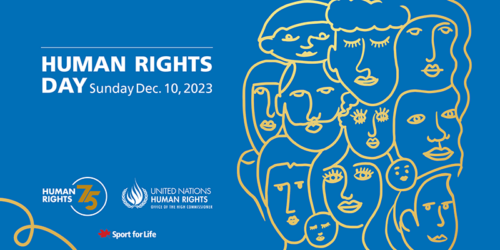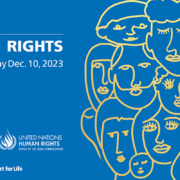Playing for a Better World
– By Joe D’Eramo, Sport for Life’s Manager of Quality Sport
 Food, music, art, and sport (and physical activity) share a common trait: they can transcend the countless differences that might otherwise appear to polarize our world. As people all over the globe engage in sport and physical activity, these both need to be human-centred and aligned with human rights. In her first statement as the Minister of Sport and Physical Activity, Minister Carla Qualtrough emphasized the importance of establishing a Canadian sport system rooted in human rights, with equality, fairness, safety, and inclusion all being core values that uphold the complex sport ecosystem in Canada.
Food, music, art, and sport (and physical activity) share a common trait: they can transcend the countless differences that might otherwise appear to polarize our world. As people all over the globe engage in sport and physical activity, these both need to be human-centred and aligned with human rights. In her first statement as the Minister of Sport and Physical Activity, Minister Carla Qualtrough emphasized the importance of establishing a Canadian sport system rooted in human rights, with equality, fairness, safety, and inclusion all being core values that uphold the complex sport ecosystem in Canada.
Sport as a Human Right
As we celebrate the 75th anniversary of the Universal Declaration of Human Rights (UDHR) on December 10, it’s important to highlight sport and physical activity’s place in this declaration. While the UDHR doesn’t explicitly mention sport or physical activity, rest, leisure, and periodic holidays encompass the right to engage in recreational activity, which includes sport and physical activity. Since the 1948 declaration, many other UN resources, such as the Convention on the Rights of the Child (CRC), the Charter of Physical Education and Sport, Sustainable Development Goals, the Convention on the Rights of Persons with Disabilities (CRPD), and the International Convention on the Elimination of All Forms of Racial Discrimination (ICERD), and others all lay the foundation for sport and physical activity being a human right.
On a Canadian level, the Canadian Charter of Rights and Freedoms and Canada’s recognition of Human Rights Day both support the overarching principles of equality and inclusion, which include access to sport and physical activity.
Tanzanian Tales
My personal journey to Tanzania in 2017 confirmed sport’s transformative power for social change. During my time there, it was abundantly clear that sport was a universal language. Connecting with locals and ‘wasafiri’ at dirt soccer pitches or parking lots turned basketball courts, it was evident that their passion for playing surpassed the conditions; participants only cared about playing and connecting, regardless of the circumstances. My Tanzanian experience highlighted the unbelievable impact sport and physical activity can have on social inclusion and community building. Nelson Mandela said it best at the 2000 Laureus World Sports Awards, “Sport has the power to change the world. It has the power to inspire. It has the power to unite people in a way that little else does. It speaks to youth in a language they understand. Sport can create hope where once there was only despair. It is more powerful than governments in breaking down racial barriers. It laughs in the face of all types of discrimination.”
Sport and physical activity promote the growth of essential human skills, i.e. life skills, like fostering belonging, effective communication, and meaningful contribution. Developing these human skills has been a growing focus in the Canadian sport system. This aligns directly with Sport for Life’s Athlete Development Matrix and Long-Term Development (LTD) 3.0 frameworks, emphasizing the holistic approach of participants through various competencies, including the social and mental aspects. These domains underscore the importance of creating quality sport environments that support positive social interactions and foster mental well-being, which is embedded in the idea of sport as a human right.
Sport for Life’s Commitment
Whether it is a reaction to the safe sport crisis we have found ourselves in or perhaps just a change in perspective on sport to a more holistic view of sport and physical activity, we as a system have made strides in the right direction to rectify the gaps identified in the areas of equity, diversity, inclusion and accessibility (EDIA), safe sport, and quality sport.
Sport for Life is no exception to this. Since the concept’s inception, quality sport’s principles, based on the LTD framework, have been: good people, good programs, and good places. Guided by these three pillars, the framework proactively combats various issues, including maltreatment, discrimination, EDIA concerns, safe sport considerations, and more. This approach ensures safe and responsible sporting and physical activity environments, allowing participants to authentically be themselves and develop holistically.
Celebrating Human Rights Day, including sport and physical activity, is not just a theoretical concept but a lived experience for many. Whether in local environments in developing nations or high-performance events on the world stage, the commitment to human and social development is at the heart of sport and physical activity. This dedication rooted in human rights encompasses striving for excellence and serving as a continuous source of inspiration, urging us all to be better humans through our engagement in sport and physical activity.

